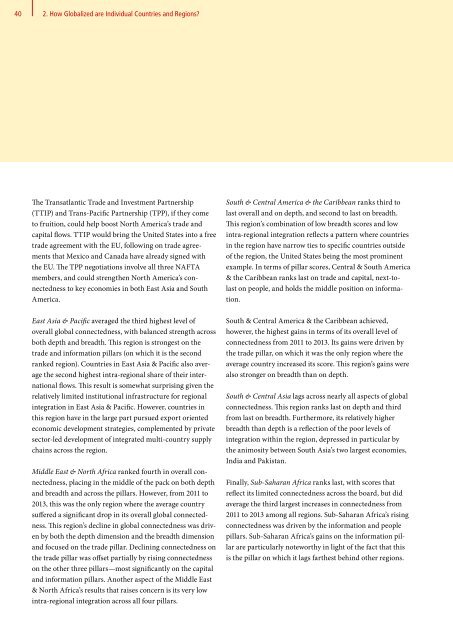DHL Global Connectedness Index 2014
DHL Global Connectedness Index 2014
DHL Global Connectedness Index 2014
- No tags were found...
Create successful ePaper yourself
Turn your PDF publications into a flip-book with our unique Google optimized e-Paper software.
40 2. How <strong>Global</strong>ized are Individual Countries and Regions<br />
The Transatlantic Trade and Investment Partnership<br />
(TTIP) and Trans-Pacific Partnership (TPP), if they come<br />
to fruition, could help boost North America’s trade and<br />
capital flows. TTIP would bring the United States into a free<br />
trade agreement with the EU, following on trade agreements<br />
that Mexico and Canada have already signed with<br />
the EU. The TPP negotiations involve all three NAFTA<br />
members, and could strengthen North America’s connectedness<br />
to key economies in both East Asia and South<br />
America.<br />
East Asia & Pacific averaged the third highest level of<br />
overall global connectedness, with balanced strength across<br />
both depth and breadth. This region is strongest on the<br />
trade and information pillars (on which it is the second<br />
ranked region). Countries in East Asia & Pacific also average<br />
the second highest intra-regional share of their international<br />
flows. This result is somewhat surprising given the<br />
relatively limited institutional infrastructure for regional<br />
integration in East Asia & Pacific. However, countries in<br />
this region have in the large part pursued export oriented<br />
economic development strategies, complemented by private<br />
sector-led development of integrated multi-country supply<br />
chains across the region.<br />
Middle East & North Africa ranked fourth in overall connectedness,<br />
placing in the middle of the pack on both depth<br />
and breadth and across the pillars. However, from 2011 to<br />
2013, this was the only region where the average country<br />
suffered a significant drop in its overall global connectedness.<br />
This region’s decline in global connectedness was driven<br />
by both the depth dimension and the breadth dimension<br />
and focused on the trade pillar. Declining connectedness on<br />
the trade pillar was offset partially by rising connectedness<br />
on the other three pillars—most significantly on the capital<br />
and information pillars. Another aspect of the Middle East<br />
& North Africa’s results that raises concern is its very low<br />
intra-regional integration across all four pillars.<br />
South & Central America & the Caribbean ranks third to<br />
last overall and on depth, and second to last on breadth.<br />
This region’s combination of low breadth scores and low<br />
intra-regional integration reflects a pattern where countries<br />
in the region have narrow ties to specific countries outside<br />
of the region, the United States being the most prominent<br />
example. In terms of pillar scores, Central & South America<br />
& the Caribbean ranks last on trade and capital, next-tolast<br />
on people, and holds the middle position on information.<br />
South & Central America & the Caribbean achieved,<br />
however, the highest gains in terms of its overall level of<br />
connectedness from 2011 to 2013. Its gains were driven by<br />
the trade pillar, on which it was the only region where the<br />
average country increased its score. This region’s gains were<br />
also stronger on breadth than on depth.<br />
South & Central Asia lags across nearly all aspects of global<br />
connectedness. This region ranks last on depth and third<br />
from last on breadth. Furthermore, its relatively higher<br />
breadth than depth is a reflection of the poor levels of<br />
integration within the region, depressed in particular by<br />
the animosity between South Asia’s two largest economies,<br />
India and Pakistan.<br />
Finally, Sub-Saharan Africa ranks last, with scores that<br />
reflect its limited connectedness across the board, but did<br />
average the third largest increases in connectedness from<br />
2011 to 2013 among all regions. Sub-Saharan Africa’s rising<br />
connectedness was driven by the information and people<br />
pillars. Sub-Saharan Africa’s gains on the information pillar<br />
are particularly noteworthy in light of the fact that this<br />
is the pillar on which it lags farthest behind other regions.





